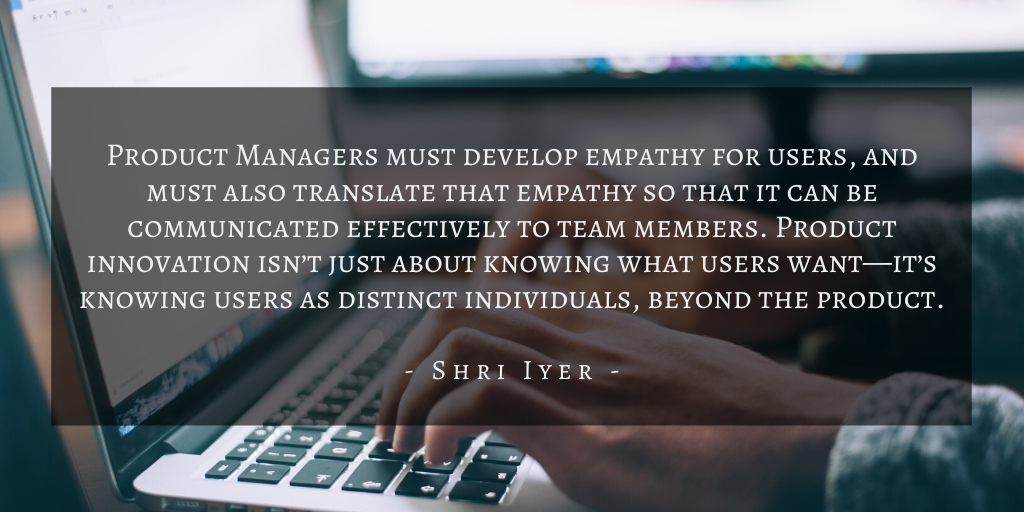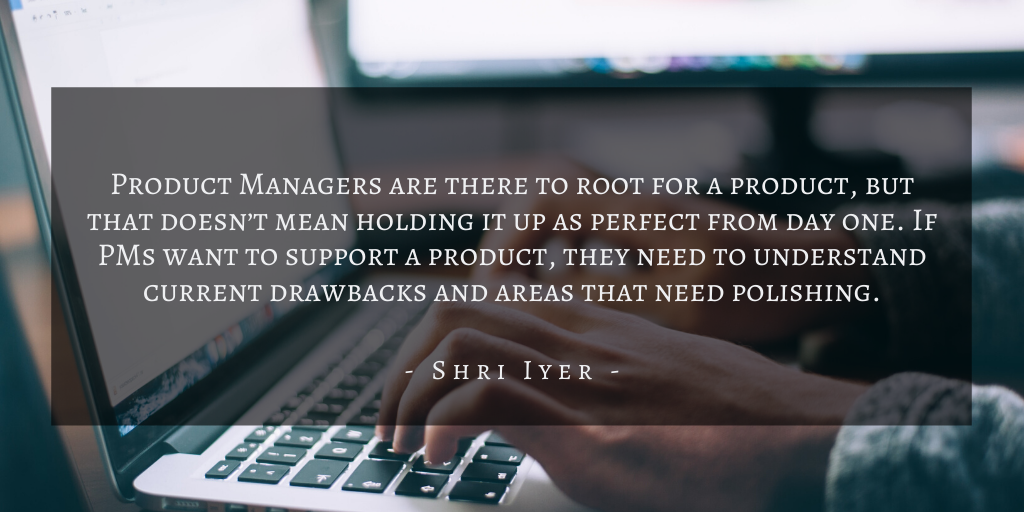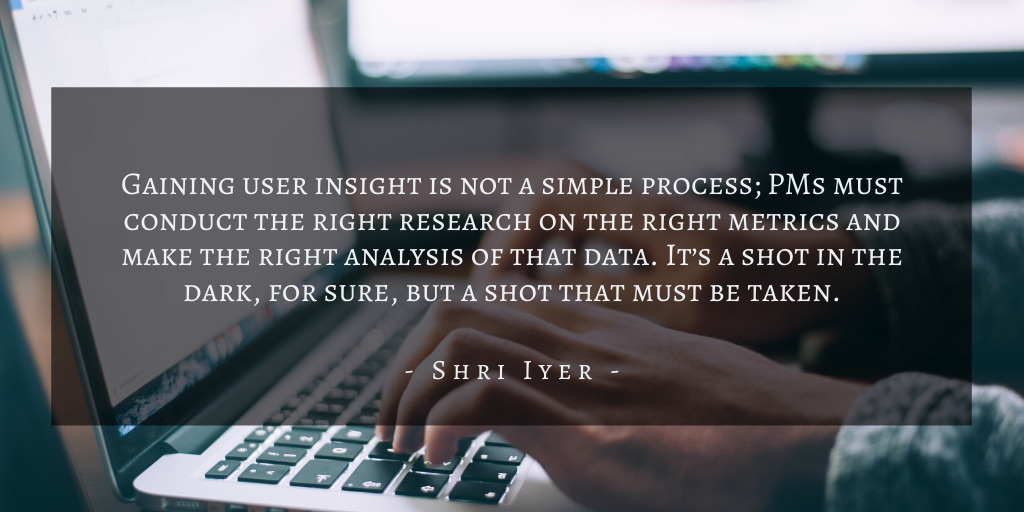More and more, Product Managers are finding that user insights are the catalyst for innovation. Through listening to feedback and gathering useful data about the status of a product and how it’s used, PMs can refine their strategies and unite the whole team behind a collective goal. In this blog, I want to explore how PMs can utilize their product users, and generate exponential innovative growth in their industry.
A Look at Product Research
Before we look at how users drive product innovation, we need to define the two types of research that can help us connect with our end-users. It’s easy to conflate the two—market and product research—but doing so invalidates the unique power of each method.
Market Research is a large-scale look at an industry or area of an industry, as well as the vast array of products and services that exist within it. It’s a way of understanding the big picture, and a good basis on which to form hypotheses about the success and validity of products.
Product Research is small-scale by comparison, and it looks at solutions for succeeding within a market niche. It’s heavily tied to an understanding of specific marketing and sales tactics, and the end result is often multimedia or metrics that can be utilized to study and promote a product.
Although they seem to be polar opposites, market and product research are equally important for the success of a product, both sales-wise and consumer feedback-wise.
Alpha has written extensively about the importance of product research, breaking the stages down into six digestible steps. These are the methods that should fit into the natural workflow of Product Managers:
- User Discovery – What problems do users have? Have they brainstormed solutions?
- Competitive Overview – What does our product currently do to solve the problem?
- Product Concept – What insights can we gain from prototyping a refined product?
- Feature Prioritization – We’ve created subtypes of these prototypes and had users test them. What feedback have we received? Which results offer the best insight as to the nature of the problem and its potential solutions?
- UX Refinement – What large- and small-scale changes would make a world of difference for users?
- Usability Assessment – As the final product is polished, what aesthetic choices will enhance the overall user experience?
In breaking the methodology down in this way, Alpha proves that, just like market research, product research is a long-term, consistent obligation for PMs.
Alpha’s writing highlights two key results from product research: identification of market opportunities, and meaningful customer insights.
How Product Research Makes Users Into Innovation Drivers
Now that we understand what comprises product research, let’s look at the actual impact of that research, particularly its influence on users. The key factor here is the importance of users when it comes to innovation. And how can we learn more about our users? Through market and product research. The latter is especially fruitful, since looking at feedback on a small-scale allows for more personalized conversations and stronger individual voices.
As product consultant and entrepreneur Britta Schell puts it, “Deep understanding of users can unlock real innovation that drives growth, engagement, and strong user relationships.” This is so true for Product Management; if we don’t understand our users, we don’t understand our product. And, since PMs are cheerleaders of their respective products, that understanding is an essential component to our jobs.

The keyword here is empathy. Product Managers must develop empathy for users, and must also translate that empathy so that it can be communicated effectively to team members. Product innovation isn’t just about knowing what users want—it’s knowing users as distinct individuals, beyond the product. How do they interact with the product? What assumptions are made about the product, and are they correct? In this regard, empathetic communication becomes its own form of data, feedback that can be put into practice.
Britta Schell made another excellent point when discussing the importance of understanding user feedback and desires for building team trust. After all, different professionals may have different ideas about what makes a product great. However, if we get word from users that a specific feature will make-or-break a product, everyone can get behind that concept. Use those user insights as core values when constructing your product, and everyone will be on the same page. We may all think we know what’s best for the user, but in the end, only the user can tell us what’s what!
Letting Users Take The Lead
Product Managers are there to root for a product, but that doesn’t mean holding it up as perfect from day one. If PMs want to support a product, they need to understand current drawbacks and areas that need polishing. Sometimes, it’s hard to see those through your own eyes, or through the eyes of developers. That’s where the end-user comes in. In fact, without user insights, PMs and developers might be wandering off in the wrong direction! Feedback from real people who would actually use the product in day-to-day life helps PMs map out what needs to be done and what should take priority.

It’s easy to waffle around between ideas, to cling to a concept we love or turn away from ones we feel aren’t worth the time. However, even if we’re married to our ideas, they may not be the best fit for our users. It’s a tough pill to swallow, to transition from our opinions to an objective view of whether or not a project is viable.
Platform development resource Justinmind describes software development as “data-driven, risk-taking, [and] innovative.” And, it posits, in order to achieve that all-important innovation, businesses must adapt to the sway of their users and customers. Justinmind gives real-world examples of companies that failed because of their inability to innovate, an issue that stemmed from the larger ignorance towards what users wanted from their products. The best examples are Nokia and Borders, which failed not because of the internet, but because of their refusal to get with the times.
The key method for understanding users’ ideas is a data-driven one. Insights into specific feedback from several users help PMs understand what major features the greater market would benefit from.
Of course, Product Managers are already pulled in several directions, dealing with development, marketing, and sales teams. It’s important that PMs incorporate market research into these interactions, as concrete evidence can help sway groups in support of a new direction. Justinmind suggests UX research at the start of each new project, which lets PMs lay out the roadmap in a logical way and gives plenty of wiggle-room for pivoting strategy early on.
Challenges To Gaining User Insight
Gaining user insight is not a simple process; PMs must conduct the right research on the right metrics and make the right analysis of that data. It’s a shot in the dark, for sure, but a shot that must be taken. And, as you gain knowledge and expertise alike in your domain, you’re bound to learn what metrics work for a product, and which ones aren’t as useful.

In addition, internal politics don’t help Product Managers to navigate the tricky world of research. As Alpha reports, “Even though product managers say that direct customer feedback is the top source of new product ideas, a startling 86% say that they don’t spend enough time talking to users.”
This begs the question: how can we find cost-effective ways to communicate with our users?
Having dealt with internal politics and low funding for products before, Product Designer Marina Popovichenko offered two quick and easy solutions in a Medium article. The Five Seconds Test involves a user getting a five-second look at a product and giving impressions on that initial viewing of the design, while the Hallway Test means simply grabbing random people from a hallway and asking them to try out the product.
In a nutshell, Marina Popovichenko’s advice is to forgo formal lab conditions. What matters is not how fancy or expensive your UX and product research set-up. At the end of the day, what matters is feedback from users who are testing the product in a neutral environment. Modern user insight tools such as Validately, UserTesting.com, and Lookback can streamline this process, generating rich user feedback and closing the empathy gap. Instead of spending precious time trying to recruit participants and set up an effective tool for measuring user input, product research software takes care of a good portion of that back-end work. Thus, PMs can get that valuable user feedback and insight for innovation simply by video-chatting and curating quick surveys.
You need to focus as much time as possible on synthesizing user research, not recruiting users or creating surveys! After all, if users aren’t 100-percent satisfied with a product, the resident PM won’t be, either. It takes a village to generate success, and every member of that village needs a voice.

